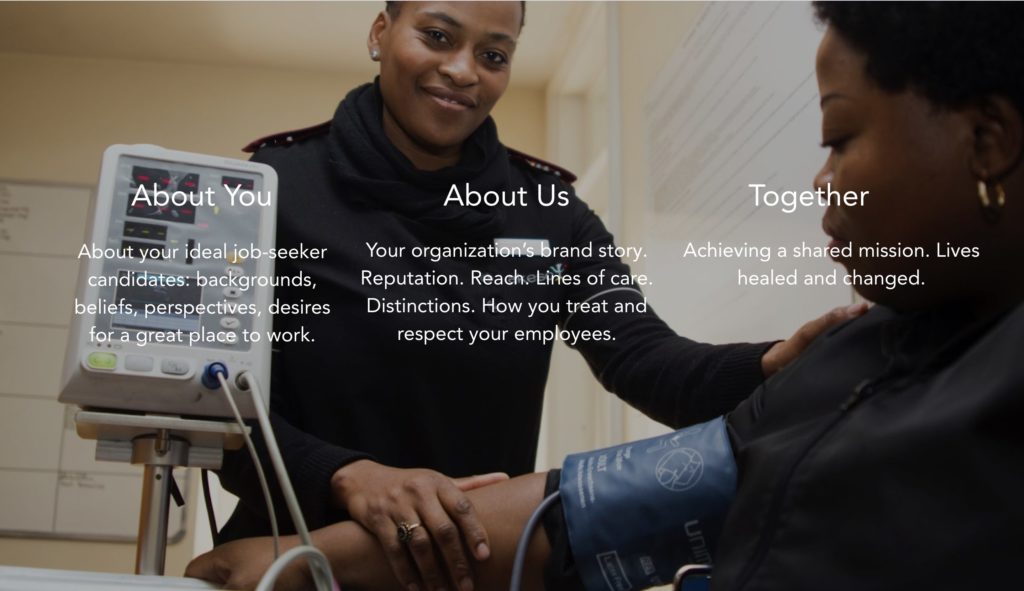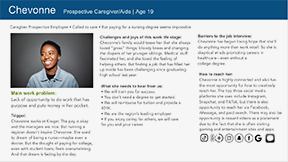According to recent studies, between 20% and 30% of front-line U.S. health care workers say they are now considering leaving their profession—for good. Traditionally, health care HR and marketing departments have worked independently. But given the staffing crisis, these departments are teaming up to address the latest pandemic crisis: recruitment. On our September 9, 2021 Campfire Chat, we discussed ways marketing can support HR in recruitment efforts.
Read below for highlights or watch the replay video. And make sure to sign up below to get notified of our next Campfire Chats webinars
Ah, the good old days of health care marketing. Remember them? We promoted key services like heart care, cancer care and joint replacement. We could predict how many patients would need care at any given time and market accordingly. Our consumer audiences were consistent in their views and attitudes about health care. When our plans were dialed in, we could reasonably anticipate what tomorrow might bring.
Then the pandemic hit.
We’ve written and spoken extensively about how health consumer audiences have changed after COVID-19, along with our strategies for helping people return for care in this “next normal”. Now, we wanted to share highlights from a recent Campfire Chat we hosted on how marketing can support health care worker recruitment.
KEY TAKEAWAYS
- Create Employer Value Propositions (EVPs) to shore up the reasons why your organization is a magnet for top talent
- Leverage consumer-facing digital channels such as Instagram and Facebook to reach hard-to-find health care workers
- Develop personalized recruitment journey experiences to attract more and better-qualified job candidates
THE STATE OF HEALTH CARE WORKER RECRUITMENT: “WE’RE GOING TO NEED A BIGGER BOAT”
Fun fact: remember that classic scene in Jaws when Roy Scheider, playing Chief Martin Brody, sees “Jaws” for the first time and says, “You’re gonna need a bigger boat”? Turns out, that line was ad-libbed. It was brilliant for the movie and prescient for this moment in health care. The traditional HR recruitment strategies that filled medical worker roles worked … until now.
The Washington Post reports that due to pandemic burnout, 3 in 10 health care workers are considering leaving the profession.
Not quitting to join another hospital.
Just simply quitting. What’s driving this mass exodus?
The article points to what I call the “Three Horsemen of the Recruitment Apocalypse”:
1. Burnout: the sheer grind of caring for COVID patients and other patients for such a prolonged time period
2. Trauma: witnessing more suffering and death than anyone can bear without emotional scars
3. Disillusionment: in the medical profession, in administrators and in others whom these medical care workers deem as having not done enough to care for them or treat this pandemic seriously
There’s also another reason for the health care worker shortage: good old-fashioned capitalism.
As health care organizations race to fill roles and shoes, a recent study reports that 93% of organizations are focused on attracting top talent and retaining them through enhanced benefits packages.
Signing bonuses of $15,000, $30,000 and more for highly sought-after medical workers are not unique in highly competitive markets these days.
What if you’re an organization that can’t throw endless stacks of money at the problem?
And what if you’re like many of our marketing clients who have operated independently from their HR counterparts, but who are starting to see a long lineup at their doors from HR colleagues asking for help with recruitment?
Well, you came to the right article.
RECRUITMENT STRATEGY #1: EMPLOYER VALUE PROPOSITIONS (EVPs)
Marketing has traditionally been the department responsible for organizational branding. For good reason. Specialist firms like Hailey Sault and our clients are classically-trained in branding and brand strategy.
Those brand strategies have traditionally focused on one audience endpoint: consumers. But that’s not quite accurate. Service brands—such as most health care brands—are made up of the people who provide the service: the nurses, the doctors, the techs, and the wonderful people who greet patients and visitors and provide so much of the incredible brand experience. In traditional brand strategy, you focus on the end user while addressing those who deliver the brand experience. Great service brands are the sum of the people who deliver those services.
Health care marketers get this. Which is why we advocate that marketing plays a pivotal role in shaping Employer Value Propositions (EVPs for short). EVPs are the distillation of the reasons why top talent should flock to the organization. Employer Value Propositions inform key messaging pillars and media channels. And, given the consensus-driven culture of many health care organizations, EVPs also help get internal teams (marketing, HR, administration, for example) on the same page.
The 3 Core Elements of Employer Value Propositions (EVPs)
1. Define why your organization’s brand is valuable and unique among medical workers
2. Describe what your ideal job candidate cares about, believes and wants to experience in a job role
3. Envision what an ideal employee can expect to create and do together with your organization
Let’s unpack these three elements.
Why is Your Brand Valuable?
What makes your organization a “great place to work”? What is the relevant, engaging and meaningful brand story of your organization? For example, why do you exist? Why and how are you improving lives and caring for your community and audiences?
What Does Your Ideal Job Candidate Care About?
The secret to great branding is a higher understanding of the ideal audience the brand seeks to serve. (More on that in a moment with regard to audience personas.) In this element, we explore what makes the ideal job candidate tick: why do they get up in the morning, what’s in their hearts and minds that your organization wants to help to cultivate with a great career?
What Does Success Look Like For Both Your Ideal Job Candidate and Your Organization?
What can your organization and your ideal job candidate expect to achieve together? What’s that grand rallying cry that only a dedicated, talented workforce can achieve when the organization does its part to provide for a great job, career, tools and support?
Steps to Developing Employer Value Propositions for Health Care Organizations
I’ll share next the basic steps for developing EVPs. For brevity purposes, I’ve kept this “topline”. (Reach out to me if you’d like more detail.)
1. Conduct an Employer Brand Diagnostic
- Interview current high-performing team members
- Interview prospective job candidates
- Interview alumni (those who have since moved on to other careers or organizations)
- Conduct a competitive analysis of what others are promoting, messaging, incentivizing)
2. Develop a summary of key benefits that employees should experience working at your organization
3. Develop your message pillars: the key messages that are authentic and resonate with your brand and top talent
Putting It All Together
Below is an example of an Employer Value Proposition framework for health care organizations. There’s no one “right” way to deliver an EVP. But this framework should give you a starting point for the employer brand journey.

RECRUITMENT STRATEGY #2: EMPLOYEE RECRUITMENT PERSONAS
If you’ve read our articles or seen us speak, you know we’re raving fans of human-centered audience personas. Personas are exceptional tools for developing strategies to inspire purchases, patient acquisition and other traditional marketing outcomes. In this competitive health care recruitment landscape, Recruitment Audience Personas are especially helpful in messaging, channel selection and converting potential job seekers into actively interviewing with your organization.
Here is the basic framework for Audience Recruitment Personas:
1. Demographic information about the ideal candidate type
2. Triggers for seeking new employment: why is he or she passively or actively looking for a new career opportunity?
3. What does the prospect need to hear from us as an organization that resonates and inspires action?
4. What is unique about us? (Among the many reasons why EVPs are so substantial in highly competitive recruitment markets.)
5. What are the barriers to job application? (Identifying how to reduce the friction from interest to job application submission.)
6. How to reach the job candidate? (Via media channels.)
How Many Audience Personas Do You Need?
Simple answer: it depends.
More nuanced answer: we like to look with our clients at the job roles of greatest need, then determine the number of audience personas to develop. For example, if any organization has three highly competitive job roles to fill, our starting point for audience persona development is three: one for each job role. Quite often, though, in our research process, we identify two or more subsets of ideal candidates to fill one medical worker role that are uniquely different enough to require their own audience personas.
So the simple answer of how many audience personas do you need stands: it depends. But the key takeaway here is to do the work. It’s valuable and essential for achieving your recruitment goal of not just getting “warm bodies” but getting the right people to fill the right shoes.
Putting It All Together
Here’s a snapshot of what a completed Hailey Sault Human-Centered Recruitment Audience Persona looks like.

RECRUITMENT STRATEGY #3: CONSUMER-DRIVEN MEDIA CHANNELS
Traditional job posting and recruitment platforms aren’t going away. But they’re simply not enough anymore to fill key roles.
That’s why we work with our marketing clients and HR contemporaries to broaden the circumference of their media channel spend and reach. We want to be in the places our job seekers spend time—Instagram, TikTok and other social channels, and to reach them in unexpected ways: through programmatic and native advertising.
Why’s that? Because using nontraditional media channels for recruitment increases the overall pool of qualified and engaged job candidates. If everyone is shouting the same thing (as is the case in traditional recruitment media channels), it’s easy to be ignored.
But! When you gain intelligence and insight on where your job seekers are spending their time, you find new and creative ways to show up in their lives. Added bonus: we have way more flexibility in message development and overall digital experience using nontraditional recruitment channels. That flexibility and digital experience creates a “stickier” connection with your audience, inviting more qualified candidates to apply.
RECRUITMENT STRATEGY #4: CUSTOMIZE THE JOB-SEEKING JOURNEY
Another one of our soapboxes is the need to personalize marketing messages and journeys to create higher engagement and conversions. This is true of both the advertising itself and the landing page experience. The same logic should be applied to your job seeker. If you’re recruiting for highly competitive roles, why would you give each candidate the same-old, same-old message and experience?
We recommend modeling the entire job-seeking journey so you identify the key inflection points to intersect with job candidates. The more personalized the experience, the better. That way, you’re delivering messaging, offers and opportunities that resonate with your audience. As we frequently hear from patients and job seekers via our marketing clients, “It’s like you know exactly what I’m thinking, feeling, and wanting”.
Exactly! That’s the ideal marketing experience: to deliver extreme value to your audiences.
We advocate creating customized landing pages for key job roles that are aligned with your audience personas. For example, we helped a client recruit urban medical workers to relocate to rural areas two hours from the city, along with recruiting within the rural area where our client’s sites of care are located. Those two audiences—urban and rural—had different messaging and landing page experiences.
Which makes sense, of course. And that’s why we helped our client to fill those critical job roles far quicker than our client’s HR counterparts could have hoped or dreamed.
But too often, especially in a highly competitive, crisis-like scenario, which we are facing with the medical worker shortage, we do what’s easy, fast or what has been done before. New times, such as these, call for new ideas, new strategies.
Which is why marketing is getting so many knocks on the office door from HR asking for help. We need new thinking to solve these new challenges.
Last Thing: Lending Support Without Inheriting Headaches
Recently, I spoke to the digital division lead for a large, national health care organization about this topic. I shared we’d been getting requested by more and more marketing teams to help them support their HR counterparts in recruitment. The digital division lead looked at me and said, “Yeah, we’ve been getting the same request for help from HR, too. So far, we’ve declined to help.”
It wasn’t because the digital lead or the marketing department didn’t want to support or help HR. It was because, let’s face it, marketing has a lot on its plate these days. As Roy Scheider said in Jaws, “You’re gonna need a bigger boat.” How much support are you willing and able to give?
Our counsel is to leverage the strategies presented in this article as a way to give your HR colleagues support via strategic branding, a higher-grade approach to modeling key audiences, and developing personalized journey experiences.
These tools are foundational to leading marketing departments—and, though I’m biased, I think a firm like Hailey Sault and many leading Chief Marketing Officers are well-qualified to guide this strategy.
But that doesn’t mean you need to become responsible for the whole kit and kaboodle. It doesn’t mean inheriting a whole new scope of work to manage. It just means working collaboratively. Flexing each other’s strengths. So you can tackle this next “all-hands” initiative.
Do you like learning new things and connecting with fun, smart people? Then you should sign up to be notified of our next Hailey Sault Campfire webinars: they’re lively video conversations without the boring bullet point slides. Sign up below to be notified of the next Campfire and get early access to our latest thinking and strategies on how to create human connections with health care marketing.



